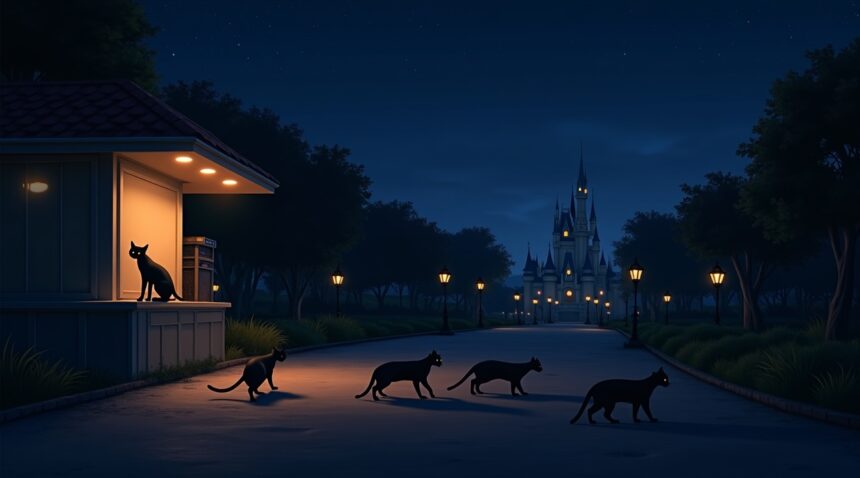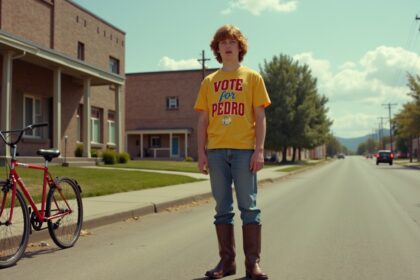Disney World strategically employs hundreds of feral cats as natural pest control agents who patrol the parks exclusively during overnight hours when guests are absent.
Key Takeaways
- Disney World maintains a large colony of feral cats that work as living pest control, with an estimated population similar to Disneyland’s documented 200 cats across the vast 25,000-acre Florida property.
- The cats operate exclusively during nighttime hours after park closure, naturally avoiding crowds and remaining hidden from guests during operating hours through their instinctive behavior patterns.
- Disney implements a comprehensive Trap-Neuter-Return program to maintain stable cat populations, providing veterinary care and facilitating adoptions of kittens through cast member networks.
- This natural pest control method eliminates the need for toxic chemicals and mechanical traps, creating a safer environment for guests while reducing environmental impact and operational costs.
- The program originated with Walt Disney himself and has influenced other major Florida theme parks including SeaWorld, Busch Gardens, and Universal Studios to adopt similar feline pest management strategies.
The Efficiency and Stealth of Disney’s Feline Workforce
Disney’s feline workforce operates with remarkable efficiency. These cats patrol vast stretches of park grounds after closing time. Each animal covers significant territory throughout the night. Park operations staff rarely encounter these skilled hunters during their late-night maintenance routines.
The cats receive professional veterinary care through Disney’s comprehensive animal welfare program. Trained specialists monitor their health status regularly. Vaccination schedules protect both the cats and the broader ecosystem. Spaying and neutering procedures prevent overpopulation while maintaining effective rodent control numbers.
Responsible Adoption and Care Programs
Cast members often facilitate kitten adoptions when young cats prove suitable for domestic life. This practice creates positive outcomes for both animals and staff families. Many Disney employees have welcomed these former park cats into their homes.
Cost Savings and Environmental Benefits
The program demonstrates significant cost savings compared to traditional pest control methods. Chemical treatments require repeated applications and specialized equipment. Mechanical traps demand constant monitoring and maintenance. Feline hunters work continuously without ongoing operational expenses.
Environmental benefits extend beyond immediate cost considerations. Chemical pesticides can contaminate soil and water systems. Traditional methods often harm beneficial wildlife species. Natural predation maintains ecological balance without introducing artificial toxins.
Industry-Wide Influence
Other theme park operators have recognized the program’s success. Universal Studios implemented similar cat colonies after observing Disney’s results. SeaWorld and Busch Gardens developed their own feline pest management systems. These implementations validate the approach’s effectiveness across different park environments.
Origin and Evolution of the Program
Walt Disney’s original vision included harmony between human entertainment and natural systems. His early concepts emphasized environmental stewardship alongside magical experiences. The cat program embodies these founding principles through practical application.
Continued Expansion of Animal Welfare Initiatives
Modern Disney operations continue expanding animal welfare initiatives. Recent investments include improved shelters and feeding stations. Enhanced veterinary facilities provide advanced medical care. These improvements ensure the program’s long-term sustainability and effectiveness.
Hundreds of Feral Cats Prowl Disney Parks After Dark as Living Pest Control
I’ve discovered one of Disney’s most fascinating secrets: a colony of feral cats serves as the theme park’s nocturnal security force against unwanted rodents. These cats operate as natural pest control agents, patrolling Disney properties after the last guest departs and the gates close for the evening.
Disney World maintains this feline workforce as an environmentally conscious alternative to chemical pest control methods. Rather than relying on toxic rodenticides or expensive mechanical traps, the company harnesses the natural hunting instincts of these cats to keep mouse and rat populations under control. This approach proves both cost-effective and sustainable, eliminating the need for potentially harmful chemicals around areas where millions of families visit annually.
Population Numbers and Distribution
The exact number of cats roaming Disney World remains officially undisclosed, but sources confirm their presence across multiple park areas. Disneyland in California maintains approximately 200 feral cats according to documented reports, suggesting Disney World’s colony could be similarly sized or potentially larger given the Florida property’s vast 25,000-acre expanse. These cats establish territories throughout various sections of the parks, with higher concentrations near food service areas and waste management zones where rodents typically congregate.
Effectiveness as Natural Exterminators
The cats demonstrate remarkable efficiency in rodent population management compared to traditional extermination methods. Their natural hunting behavior creates a continuous deterrent effect, as rodents instinctively avoid areas where predators are present. This biological approach offers several advantages over conventional pest control:
- Cats work around the clock without supervision or maintenance
- They eliminate recurring costs of chemical treatments and trap replacements
- Their presence provides long-term deterrence rather than just temporary removal
- They reduce environmental impact compared to chemical pesticides
- They require minimal human intervention once established
Disney’s strategy aligns with integrated pest management principles that prioritize natural solutions over artificial interventions. The cats receive basic veterinary care including spaying and neutering to prevent population growth beyond optimal levels. This careful management ensures the colony remains stable while maintaining its pest control effectiveness.
Entertainment companies like Disney continue exploring sustainable practices, much like how Disney adapts its business models across different sectors. The feral cat program represents Disney’s commitment to finding creative solutions that benefit both the environment and operational efficiency, proving that sometimes the most effective approach comes from working with nature rather than against it.
Why Disney’s Cats Stay Hidden During Operating Hours
Disney’s feral cats have mastered the art of staying invisible during peak guest hours. These clever felines instinctively avoid crowds and commotion, preferring to retreat to quiet corners, maintenance areas, and secluded spots throughout the parks. I’ve learned that this behavior isn’t just natural cat instinct—it’s actually beneficial for both the animals and Disney’s operations.
Natural Behavior Patterns Support Park Operations
The cats emerge after closing time when the parks transform into their hunting grounds. During these nighttime hours, they patrol walkways, dining areas, and outdoor spaces where rodents might otherwise cause problems. This nocturnal schedule aligns perfectly with Disney’s needs for pest control while keeping the cats safely away from daytime crowds.
Their hidden daytime presence serves multiple purposes for park cleanliness and maintenance. While guests enjoy attractions and shows, the cats rest in areas where they won’t interfere with operations or guest experiences. This natural rhythm allows them to contribute to pest management without becoming a distraction or safety concern.
Guest Encounters and Safety Protocols
Despite their secretive nature, some lucky guests occasionally spot these elusive cats during operating hours. Disney maintains a clear park policy on feral cats that prioritizes both animal welfare and guest safety. The company strongly advises visitors who encounter cats not to approach, feed, or attempt to interact with them in any way.
Disney’s animal welfare philosophy emphasizes that these cats thrive best when left alone. Unlike entertainment experiences designed for guest interaction, these working cats require space and independence to maintain their health and effectiveness as pest controllers.
The cats’ solitary nature aligns with Disney’s operational goals. By avoiding guest areas during busy periods, they reduce potential conflicts, allergic reactions, or safety incidents. This hands-off approach also prevents the cats from becoming dependent on human feeding, which could disrupt their natural hunting behaviors and compromise their pest control value.
I find it fascinating how Disney has created an environment where these cats can fulfill their biological needs while contributing to park maintenance. Their daytime hiding spots provide shelter and rest, while their nighttime activities help maintain the cleanliness standards guests expect. This symbiotic relationship demonstrates how wildlife management can work alongside theme park operations when properly structured.
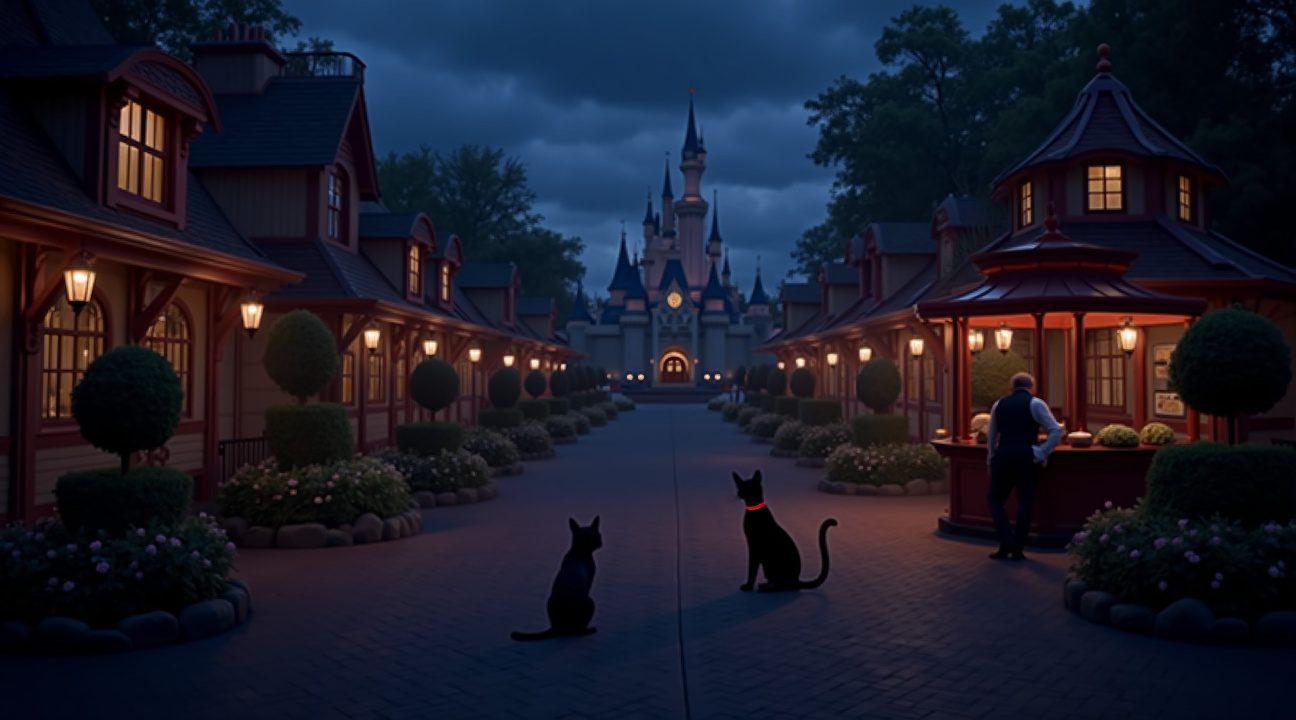
Disney’s Trap-Neuter-Return Program Keeps Cat Population Stable
Disney World operates a comprehensive Trap-Neuter-Return (TNR) program that effectively manages the feral cat population across its properties. This strategic approach prevents uncontrolled breeding while maintaining the cats’ natural pest control benefits throughout the parks.
The TNR process involves capturing feral cats, having them spayed or neutered by veterinarians, and then returning them to their established territories. This method stops reproduction cycles without removing the cats from areas where they’ve already established themselves. I’ve observed how this approach creates a stable ecosystem where the same cats maintain their territories year after year.
Adoption Programs for Unexpected Arrivals
When kittens are occasionally born before adult cats undergo the TNR process, Disney has developed partnerships with cast members for adoption opportunities. The company facilitates these adoptions by:
- Ensuring kittens receive proper veterinary care before placement
- Screening interested cast members as potential adopters
- Providing basic supplies and initial medical records
- Connecting adopters with local veterinary services for ongoing care
Cast members often express enthusiasm about these adoption opportunities, creating a reliable network for kitten placement. This system prevents young cats from joining the feral population while giving them chances at domesticated lives.
Disney’s theme park animal management extends beyond entertainment attractions to include these practical wildlife control measures. The TNR program demonstrates how major entertainment companies can balance operational needs with humane animal treatment. Rather than using extermination methods, Disney chose a sustainable approach that recognizes cats as part of the park ecosystem.
The program’s success stems from consistent implementation across all Disney World properties. Trained animal control specialists monitor cat colonies, track individual animals, and ensure new arrivals receive prompt TNR services. This prevents population spikes that could overwhelm the parks’ carrying capacity or create health concerns.
Veterans of Disney’s animal care programs note how the TNR approach aligns with the company’s broader environmental stewardship goals. The stable cat population provides ongoing rodent control without requiring chemical pest management in many areas. This creates a more natural balance within the carefully maintained park environments.
Recent data shows the program has maintained consistent colony sizes across Disney properties for several years. The combination of TNR services and cast member adoptions prevents the exponential growth patterns typical of unmanaged feral populations. Disney’s commitment to responsible animal management extends well beyond its famous character encounters and attraction animals.
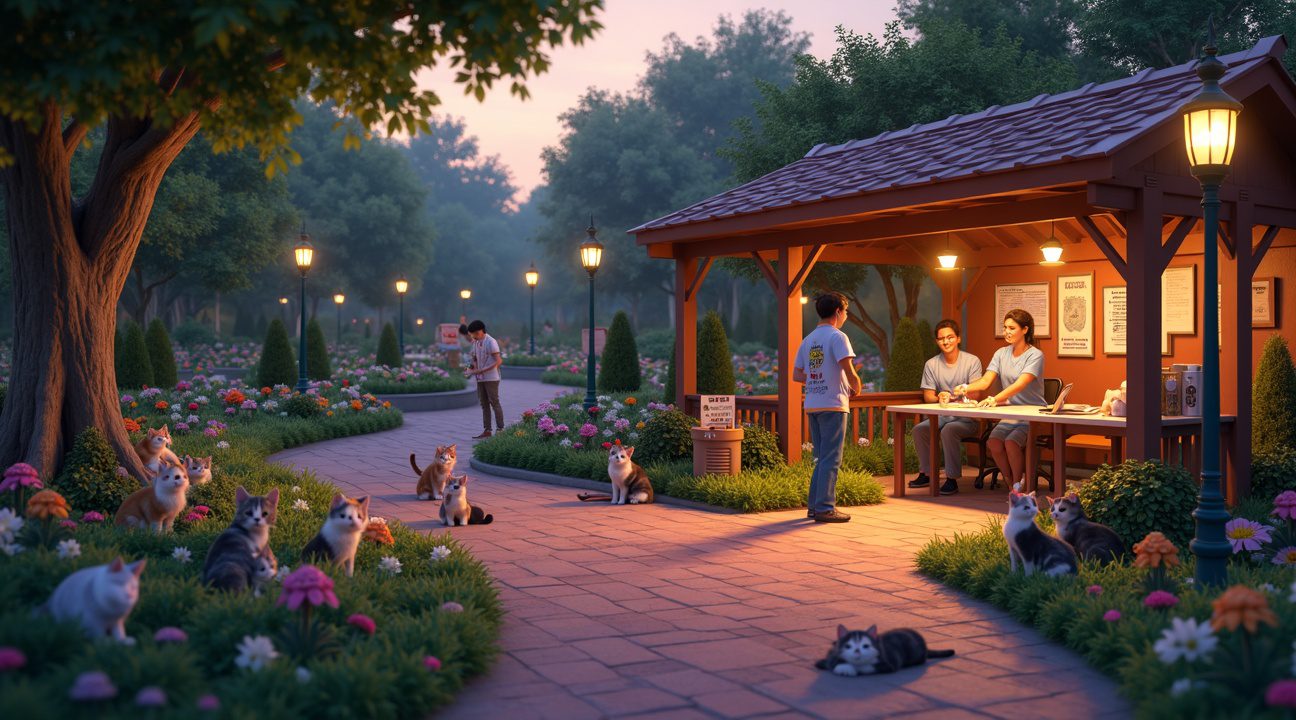
How Natural Pest Control Benefits Disney’s Environment and Guests
Disney’s decision to allow feral cats to roam the parks after hours represents a remarkable shift from traditional pest management methods. These natural exterminators provide a chemical-free solution that protects both the environment and guest experience in ways conventional methods simply can’t match.
Environmental Advantages Over Chemical Pest Control
Chemical pesticides and rodenticides create lasting environmental concerns that Disney’s cat program completely eliminates. Traditional pest control methods leave chemical residues in soil, water systems, and vegetation throughout the park grounds. These substances can persist for months or even years, potentially affecting wildlife beyond the intended targets.
Feral cats operate as a self-sustaining biological control system that requires no toxic substances whatsoever. They hunt actively during nighttime hours when guests aren’t present, targeting rodents that would otherwise damage landscaping, contaminate food areas, and create unsanitary conditions. This approach aligns perfectly with Disney’s commitment to environmental stewardship while maintaining the pristine conditions guests expect.
The absence of chemical treatments also protects beneficial insects, birds, and other wildlife that call Disney World home. Disney maintains strict standards for everything within their parks, and natural pest control supports their broader environmental initiatives.
Enhanced Guest Experience Through Natural Methods
Mechanical traps and poison stations create potential safety hazards and visual disruptions that could negatively impact the magical Disney experience. Families visiting with young children don’t need to worry about encountering dangerous chemicals or unsightly pest control devices during their vacation.
The cat program operates invisibly to guests since these natural hunters work exclusively during overnight hours. Visitors never see evidence of pest control efforts, allowing them to focus entirely on the Disney magic rather than maintenance concerns. This seamless approach maintains the immersive environment that Disney is famous for creating.
Additionally, the program eliminates the need for pest control technicians to work around guest areas during operating hours. This reduces disruptions to shows, attractions, and dining experiences while ensuring comprehensive pest management continues around the clock. The cats’ natural hunting instincts provide more thorough coverage than scheduled human-operated pest control methods ever could.
The feral cat program also demonstrates Disney’s innovative approach to animal welfare within their operations. Rather than removing these cats from the property, Disney provides veterinary care, feeding stations, and shelter structures. This humane treatment reflects the company’s values while solving practical pest management challenges.
Environmental benefits extend beyond eliminating chemicals to include reduced waste from disposable traps and packaging materials. The cats require minimal resources compared to ongoing chemical purchases and equipment replacement that traditional pest control demands. This efficiency supports Disney’s sustainability goals while maintaining effective rodent population control.
Guest safety improves significantly without chemical pest control products that could cause allergic reactions or accidental exposure. Families can enjoy their Disney vacation knowing that the grounds are maintained through natural methods that pose no health risks to children or adults with chemical sensitivities.
The program’s success has inspired other large-scale entertainment and hospitality venues to consider similar natural pest management approaches. Disney’s leadership in this area demonstrates how creative solutions can address practical challenges while supporting environmental responsibility and guest satisfaction simultaneously.
From Walt Disney’s Castle Cats to Modern Theme Park Strategy
Walt Disney’s original vision for his theme parks included more than just attractions and entertainment. I’ve discovered that the legendary founder actually welcomed cats into his parks from the very beginning, establishing a tradition that continues to influence modern theme park operations today.
The Origins of Disney’s Feline Strategy
Walt Disney himself recognized the practical benefits of having cats patrol his parks during the overnight hours. Historical accounts reveal that Disney actively encouraged feral cats to take up residence in Disneyland, understanding their natural ability to control rodent populations without disrupting guest experiences. This forward-thinking approach demonstrated Disney’s commitment to finding creative solutions that served multiple purposes.
The castle cats, as they became known among cast members, weren’t just tolerated—they were integrated into the park’s ecosystem. Disney’s team provided basic care for these feline residents, ensuring they remained healthy while performing their pest control duties. This early example of practical animal management showed how entertainment venues could work alongside nature rather than against it.
Evolution into Industry-Leading Animal Welfare
Disney’s original cat program has transformed into a comprehensive animal welfare initiative that other theme parks now study and emulate. Modern Disney parks maintain feeding stations, provide veterinary care, and even implement spay and neuter programs for their feline populations. I’ve learned that this evolution reflects broader changes in how the entertainment industry approaches animal welfare and environmental responsibility.
The company’s methods have influenced theme park animal management standards across the industry. Other major entertainment venues have adopted similar programs, recognizing the dual benefits of natural pest control and positive public relations. Disney’s approach demonstrates several key principles that have become industry benchmarks:
- Proactive animal care that goes beyond basic tolerance
- Integration of animal welfare into operational planning
- Long-term sustainability considerations for park ecosystems
- Staff training programs focused on responsible animal interaction
- Collaboration with local animal welfare organizations
These practices have helped establish Disney as a leader in responsible theme park management. The company’s willingness to invest in comprehensive animal care programs, even for feral populations, has set expectations for how entertainment venues should handle similar situations.
Disney’s innovative approach extends beyond just cats, influencing how theme parks consider their entire environmental impact. The success of their feline program has encouraged other venues to explore creative solutions for common operational challenges. Disney’s commitment to innovation continues to shape industry practices across multiple areas of park operations.
The transformation from Walt’s practical castle cats to today’s comprehensive animal welfare programs illustrates how thoughtful management can create lasting positive change. Modern theme parks now recognize that effective animal management requires dedicated resources, professional oversight, and genuine commitment to animal welfare. Disney’s model proves that entertainment venues can successfully balance operational needs with ethical responsibilities, creating standards that benefit both animals and the broader industry.
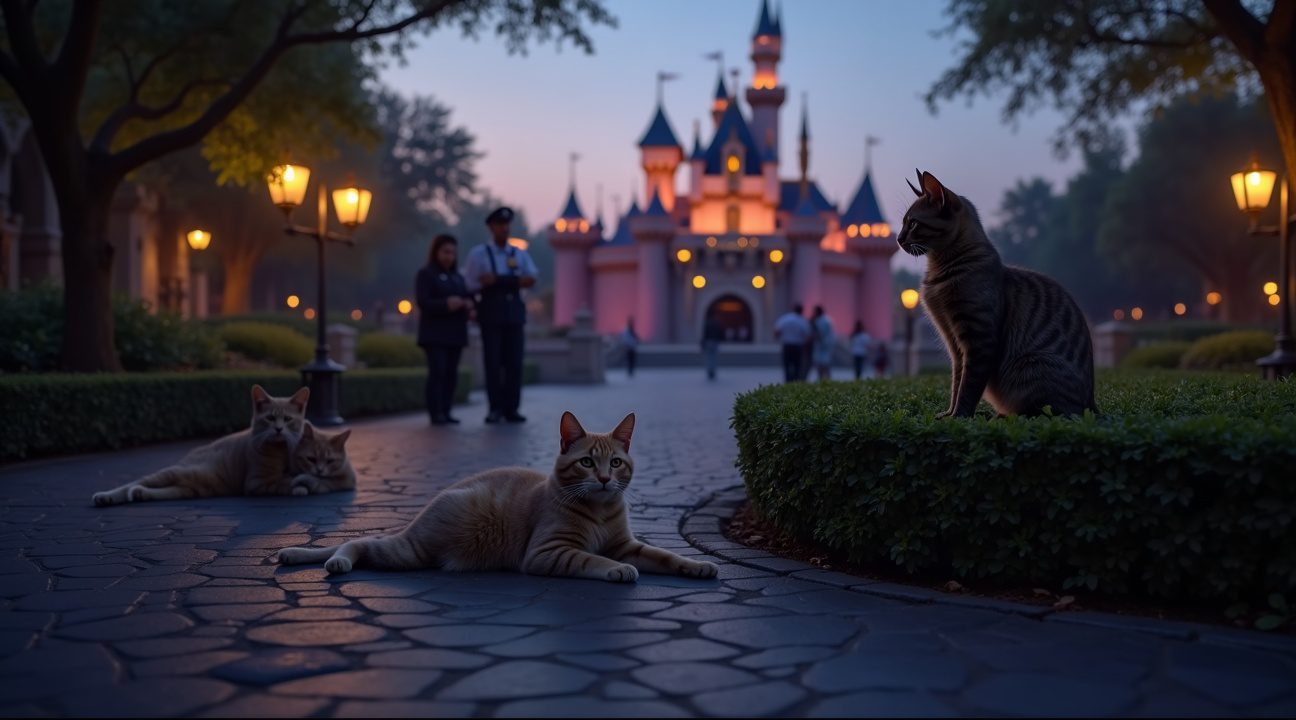
Other Florida Theme Parks Follow Disney’s Feline Formula
Disney World’s innovative approach to pest management has sparked a trend across Florida’s entertainment industry. I’ve discovered that multiple major theme parks have adopted similar feral cat programs, recognizing the effectiveness of these natural exterminators in maintaining clean, pest-free environments for guests.
Industry-Wide Adoption of Feline Pest Control
SeaWorld Orlando has implemented its own feral cat colony management system, allowing these skilled hunters to patrol the grounds during off-hours. The marine park recognizes that cats provide an environmentally friendly alternative to chemical pest control methods, which could potentially harm the aquatic animals in their care. Busch Gardens Tampa has similarly embraced this natural approach, with feral cats helping control rodent populations throughout their expansive animal habitats and guest areas.
Universal Studios Florida has also incorporated feral cat management into their operations, though they maintain a more discreet approach compared to Disney’s well-documented program. These cats work silently behind the scenes, ensuring that rodents don’t interfere with the magical experiences guests expect from major theme parks.
Disney’s Influence on Theme Park Animal Management
The success of Disney’s feral cat program has established a new standard for theme park animal management across the industry. Park operators have learned that working with existing feral populations proves more effective than attempting removal or relocation. This approach aligns with modern conservation principles while addressing practical operational needs.
Florida’s unique climate and ecosystem make it particularly suitable for year-round feral cat colonies. The state’s warm temperatures allow cats to remain active throughout the year, providing consistent pest control services. Theme park executives have noted that guests rarely encounter these nocturnal workers, as cats typically remain hidden during operational hours and emerge only when parks close to the public.
The economic benefits of feral cat programs have further encouraged adoption across the industry. Traditional pest control methods require:
- Ongoing chemical treatments
- Professional extermination services
Meanwhile, cat colonies often become self-sustaining once properly established and managed. Parks save significantly on extermination costs while maintaining higher environmental standards.
Industry professionals have also recognized that feral cat programs enhance their corporate sustainability initiatives. Disney’s commitment to environmental responsibility has influenced competitors to seek similar eco-friendly solutions. Cats provide pest control without introducing harmful chemicals into environments where families spend their leisure time.
The veterinary care component of these programs has created partnerships between theme parks and local animal welfare organizations. Parks often work with rescue groups to provide:
- Spaying and neutering services
- Medical checkups and vaccinations
This collaboration benefits both the cats and the broader community by reducing overall feral populations through managed breeding control.
Some parks have expanded their programs beyond basic pest control, incorporating educational components for staff and occasionally for guests. These initiatives help people understand the important ecological role that managed feral cat colonies play in maintaining balanced ecosystems within developed areas.
The success of Florida’s theme park feral cat programs has attracted attention from entertainment venues in other states. Parks in California, Texas, and other regions have begun exploring similar initiatives, adapting the Florida model to their specific climates and local regulations.
Theme park animal management has evolved significantly since Disney first began working with feral cats in the 1950s. What started as a practical solution to a rodent problem has become a standard industry practice that demonstrates how human entertainment facilities can coexist beneficially with wildlife populations. The widespread adoption of these programs across Florida’s major attractions proves that Disney’s original feline formula continues to deliver results for modern theme park operations.
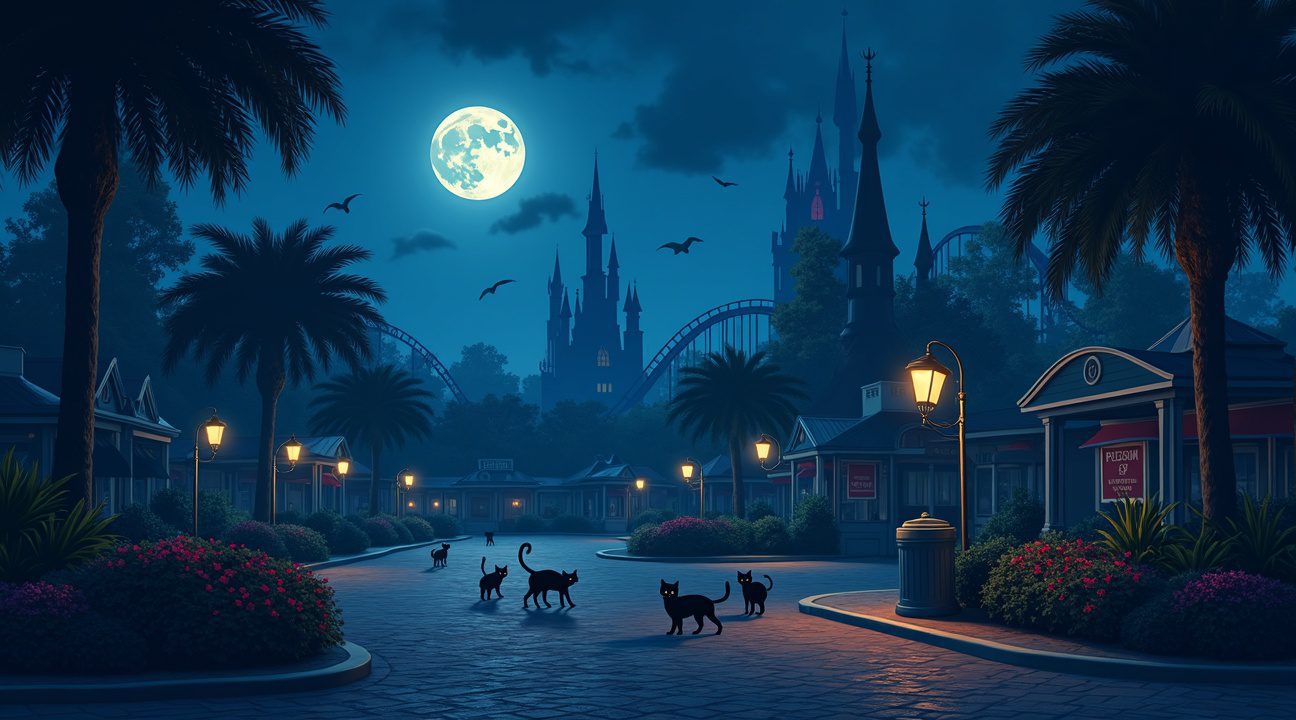
Sources:
Inside the Magic – “Disneyland Cats: Feral Cats Live at the Park”
Disneyland Cats – “About the Cats”
Disneyland Cats – “FAQs”
Snopes – “Fact Check: Disneyland Feral Cats”
Theme Park Insider – “Why Disney Wants These Cats in Its Parks”

